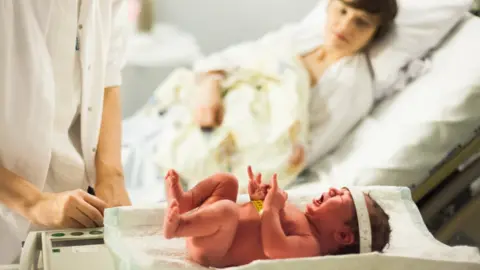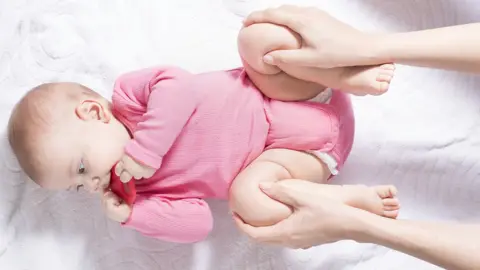Newborn hip checks 'have failed to prevent late diagnosis'
 Getty Images
Getty ImagesThe current system of checking newborns for hip problems is failing, resulting in too many late diagnoses and corrective surgery, a study suggests.
All newborns in England have their hips examined but only those at risk or with problems receive a scan.
Surgeons from Southampton Children's Hospital said the rate of late diagnoses had not improved since screening started, over 30 years ago.
But Public Health England said scanning all newborns could cause more problems.
Developmental dysplasia of the hip (DDH), if picked up early in babies, can be treated using a removable splint worn for two to three months.
But if there is a delay in diagnosis of up to a year or more, untreated hip dysplasia can lead to a shortened leg, surgery and the risk of continuing hip pain and long-term complications.
Alexander Aarvold, study author and consultant orthopaedic surgeon at Southampton, said untreated hip dysplasia was "a significant public health issue" and the current approach had "failed to impact" on late diagnoses in children.
"The signs are easily missed. They can be subtle," he said.
"Doctors, midwives and nurses may be doing the checks and if they are not used to seeing hip dysplasia, it is hard to pick up."
 Getty Images
Getty ImagesThe research, by orthopaedic surgeons in The Bone and Joint Journal, looked at 754 cases of children diagnosed late with the hip problem - defined as after the age of one - between 1990 and 2016, a rate of 1.28 cases per 1,000 births.
But UK studies before the hip screening programme began, in 1986, show the rate of late diagnoses then was only 0.88 per 1,000 births.
And smaller regional studies from the 1960s and 70s reveal even lower figures.
Tim Theologis, president of the British Society for Children's Orthopaedic Surgery, said: "This study has provided evidence that the current selective screening for neonatal hip dysplasia is ineffective and the percentage of infants diagnosed late is unacceptably high."
Other countries, such as Germany and Austria, perform ultrasound scans of the hips of all newborns - and late diagnosis is extremely low there.
But Prof Anne Mackie, director of screening at Public Health England, said: "Offering a universal scan can cause more harm and evidence shows that it can lead to 20 times more babies being unnecessarily treated compared to the UK programme.
"We know that wearing a splint in the crucial early months can affect the bond between mother and baby and can also cause avascular necrosis where the hip 'dies'."
PHE said it was planning to introduce some changes to the screening process and looking at more training for clinicians carrying out the examinations.
What is developmental dysplasia of the hip?
It's a condition where the "ball and socket" joint of the hip does not form properly.
This socket of the hip is too shallow and so the head of the thigh bone is not held tightly in place, making the hip joint loose. Sometimes, it can come out of the socket or dislocate
Babies' hips are checked as part of a physical examination within 72 hours of being born and again at six to eight weeks old.
The examination involves gentle manipulation of a baby's hip joints to check if there are any problems.
DDH is more common in girls than boys and more common in the left hip.
Without treatment, DDH may lead to problems later in life, including:
- developing a limp
- hip pain - especially during the teenage years
- painful and stiff joints (osteoarthritis)
With early diagnosis and treatment, most children are able to develop normally and have a full range of movement in their hip.
Source: NHS UK
